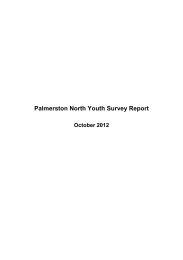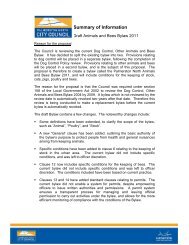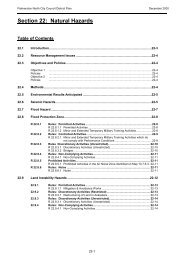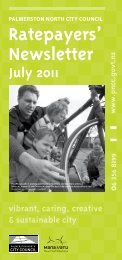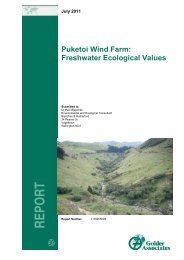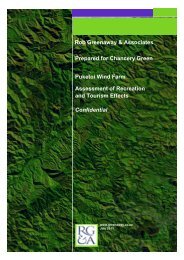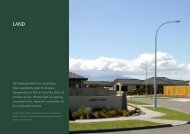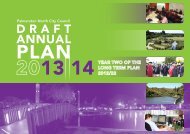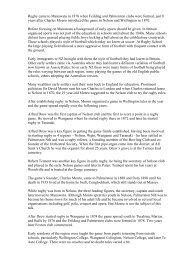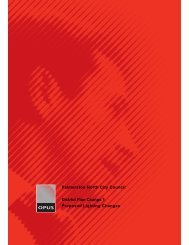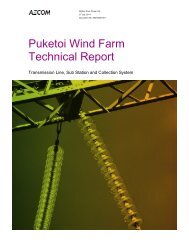2011-2012 Annual Report - Full Version - PDF - Palmerston North ...
2011-2012 Annual Report - Full Version - PDF - Palmerston North ...
2011-2012 Annual Report - Full Version - PDF - Palmerston North ...
- No tags were found...
Create successful ePaper yourself
Turn your PDF publications into a flip-book with our unique Google optimized e-Paper software.
Carpark leasesAcquired carpark leases are capitalised on the basis ofthe costs incurred to acquire and bring to use the specificcarparks.AmortisationThe carrying value of an intangible asset with a finite lifeis amortised on a straight-line basis over its useful life.Amortisation begins when the asset is available for useand ceases at the date that the asset is derecognised. Theamortisation charge for each period is recognised in thesurplus or deficit.The useful lives and associated amortisation rates of majorclasses of intangible assets have been estimated as follows:Computer software and licencesAthletic trackCarpark leases3-7 years9 years50 yearsImpairment of property, plant and equipmentand intangible assetsIntangible assets that have an indefinite useful life, or notyet available for use, are not subject to amortisation andare tested annually for impairment. Assets that have a finiteuseful life are reviewed for indicators of impairment at eachbalance date. When there is an indicator of impairment theasset’s recoverable amount is estimated. An impairment lossis recognised for the amount by which the asset’s carryingamount exceeds its recoverable amount. The recoverableamount is the higher of an asset’s fair value less costs to selland value in use.Value in use is optimised depreciated replacement costfor an asset where the future economic benefits or servicepotential of the asset are not primarily dependent on theasset’s ability to generate net cash inflows and where PNCCwould, if deprived of the asset, replace it’s remaining futureeconomic benefits or service potential.The value in use for cash generating assets and cashgenerating units is the present value of expected futurecash flows.If an asset’s carrying amount exceeds its recoverableamount, the asset is impaired and the carrying amountis written down to the recoverable amount. For revaluedassets the impairment loss is recognised in othercomprehensive income and against the revaluation reservefor that class of asset. Where that results in a debit balancein the revaluation reserve, the balance is recognised in thesurplus or deficit.For assets not carried at a revalued amount, the totalimpairment loss is recognised in the surplus or deficit.The reversal of an impairment loss on a revalued asset isincluded in other comprehensive income and creditedto the revaluation reserve. However, to the extent thatan impairment loss for that class of asset was previouslyrecognised in the surplus or deficit, a reversal of theimpairment loss is also recognised in the surplus or deficit.For assets not carried at a revalued amount (other thangoodwill) the reversal of an impairment loss is recognisedin the surplus or deficit.Forestry assetsStanding investment forestry assets are independentlyrevalued annually at fair value less estimated costs to sellfor one growth cycle. Fair value is determined based onthe present value of expected net cash flows discountedat a current market determined pre-tax rate. Thiscalculation is based on existing sustainable felling plansand assessments regarding growth, timber prices, fellingcosts and silvicultural costs and takes into considerationenvironmental, operational and market restrictions.Gains or losses arising on initial recognition of biologicalassets at fair value less estimated costs to sell and froma change in fair value less estimated costs to sell arerecognised in the surplus or deficit.The costs to maintain the forestry assets are included in thesurplus or deficit when incurred.Compensating emission units relating to pre-1990 forestland are recorded at a nil cost. Possible deforestationpenalties relating to pre-1990 forest land are not recognised.Refer Note 27 for details.Investment propertyProperties leased to third parties under operating leasesare classified as investment property unless the property isheld to meet service delivery objectives, rather than to earnrentals or for capital appreciation.Investment property is measured initially at its cost,including transaction costs.After initial recognition, PNCC measures all investmentproperty at fair value as determined annually by anindependent valuer.Gains or losses arising from a change in the fair value ofinvestment property are recognised in the surplus or deficit.Trade and other payablesTrade and other payables are initially measured at fair valueand subsequently measured at amortised cost using theeffective interest method.Employee benefitsShort-term employee benefitsEmployee benefits that PNCC expects to be settled within12 months of balance date are measured at nominal valuesbased on accrued entitlements at current rates of pay.These include salaries and wages accrued up to balancedate, annual leave earned, but not yet taken at balancedate, retiring and long service leave entitlements expectedto be settled within 12 months, time in lieu and sick leave.PNCC recognises a liability for sick leave to the extent thatcompensated absences in the coming year are expectedto be greater than the sick leave entitlements earned inthe coming year. The amount is calculated based on theunused sick leave entitlement that can be carried forwardat balance date, to the extent that PNCC anticipates it willbe used by staff to cover those future absences.Long-term employee benefitsEntitlements that are payable beyond 12 months, such aslong service leave and retiring leave, have been calculatedon an actuarial basis. The calculations are based on:• likely future entitlements accruing to staff, based onyears of service, years to entitlement, the likelihoodthat staff will reach the point of entitlement andcontractual entitlements information, and• the present value of the estimated future cash flowsdiscounted at a current market determined rate.Superannuation schemesDefined contribution schemes - Obligations forcontributions to defined contribution superannuationschemes are recognised as an expense in the surplus ordeficit as incurred.Defined benefit schemes - PNCC belongs to the DefinedBenefit Plan Contributors Scheme (the scheme), which ismanaged by the Board of Trustees of the National ProvidentFund. The scheme is a multi-employer defined benefitscheme.Financial Statements Note 1<strong>Palmerston</strong> <strong>North</strong> City Council <strong>Annual</strong> <strong>Report</strong> <strong>2011</strong>/12143



